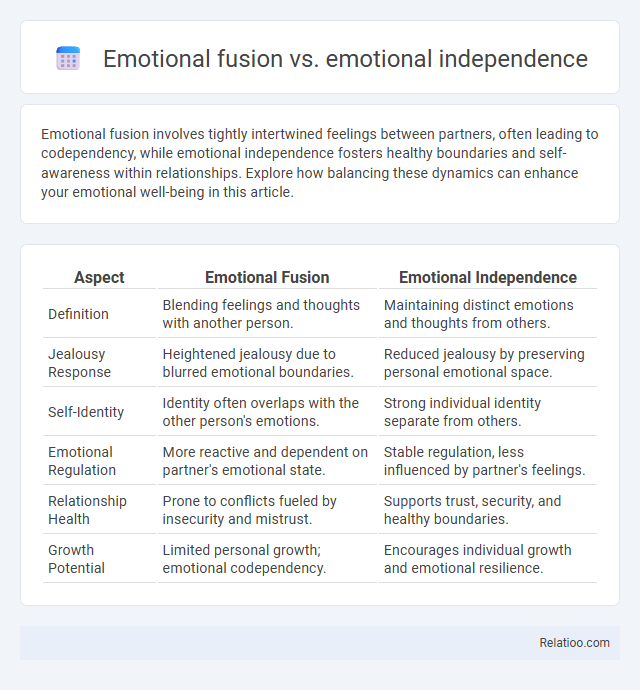Emotional fusion involves tightly intertwined feelings between partners, often leading to codependency, while emotional independence fosters healthy boundaries and self-awareness within relationships. Explore how balancing these dynamics can enhance your emotional well-being in this article.
Table of Comparison
| Aspect | Emotional Fusion | Emotional Independence |
|---|---|---|
| Definition | Blending feelings and thoughts with another person. | Maintaining distinct emotions and thoughts from others. |
| Jealousy Response | Heightened jealousy due to blurred emotional boundaries. | Reduced jealousy by preserving personal emotional space. |
| Self-Identity | Identity often overlaps with the other person's emotions. | Strong individual identity separate from others. |
| Emotional Regulation | More reactive and dependent on partner's emotional state. | Stable regulation, less influenced by partner's feelings. |
| Relationship Health | Prone to conflicts fueled by insecurity and mistrust. | Supports trust, security, and healthy boundaries. |
| Growth Potential | Limited personal growth; emotional codependency. | Encourages individual growth and emotional resilience. |
Understanding Emotional Fusion
Emotional fusion occurs when individuals overly depend on each other's feelings, leading to blurred boundaries and reduced personal autonomy. Emotional independence emphasizes maintaining distinct emotional experiences and self-regulation, fostering healthy relationships without overwhelming dependence. Understanding emotional fusion is crucial for recognizing patterns where emotions are enmeshed, allowing for improved emotional awareness and the development of balanced interpersonal connections.
Defining Emotional Independence
Emotional independence refers to the ability to maintain a stable sense of self and emotional well-being without relying heavily on others for validation or emotional support. Unlike emotional fusion, where individuals excessively depend on others' feelings and approval, emotional independence fosters self-awareness, resilience, and personal boundaries. This concept is essential in healthy relationships, promoting mutual respect and balanced emotional engagement without codependency.
Key Differences Between Fusion and Independence
Emotional fusion involves a blurring of individual boundaries where partners overly depend on each other for emotional validation, often leading to codependency and reduced personal autonomy. Emotional independence emphasizes maintaining personal identity and self-regulation within relationships, allowing for healthy interdependence without losing oneself. The key difference lies in fusion's tendency toward enmeshment, whereas independence promotes balanced connections with clear emotional boundaries.
Psychological Origins of Emotional Fusion
Emotional fusion originates from early attachment experiences, where your sense of self becomes intertwined with significant others, leading to blurred emotional boundaries. This psychological pattern often stems from enmeshed family dynamics, causing difficulty in distinguishing your own feelings from those of others. Emotional independence develops as individuals form clear, autonomous emotional identities, allowing healthier relationships and personal growth.
Benefits of Emotional Independence
Emotional independence enhances your ability to regulate feelings, fostering self-awareness and resilience without relying on others for validation. This state promotes healthier relationships by reducing codependency and encouraging clear communication. Benefits include stronger mental health, increased confidence, and a balanced sense of self.
Consequences of Emotional Fusion in Relationships
Emotional fusion in relationships can lead to a loss of personal boundaries, causing partners to lose their sense of individuality and emotional autonomy. This often results in increased dependency, where your emotions become intertwined with your partner's mood, making conflict resolution more challenging and intensifying feelings of anxiety and resentment. Emotional independence, by contrast, fosters a healthy balance where both partners support each other's growth while maintaining their unique identities.
Developing Emotional Independence
Developing emotional independence enhances personal growth by fostering self-awareness and resilience, allowing individuals to regulate emotions without over-reliance on others. Unlike emotional fusion, where boundaries blur and feelings are shared excessively, emotional independence promotes clear distinctions between one's emotions and those of others. Cultivating emotional independence supports healthier relationships by encouraging balanced emotional connections and preventing codependency.
Balancing Connection and Autonomy
Balancing connection and autonomy requires understanding the differences between emotional fusion, emotional independence, and emotional differentiation. Emotional fusion involves deeply intertwined feelings and reliance on another for validation, which can hinder personal autonomy. Emotional independence fosters self-reliance and clear personal boundaries, while emotional differentiation supports a healthy balance by allowing individuals to maintain intimate connections without losing their unique identity.
Common Signs of Emotional Fusion
Common signs of emotional fusion include an inability to separate your feelings from others, a persistent need for approval, and difficulty making decisions without external validation. You may experience heightened anxiety when relationships face conflict, as emotional boundaries are blurred and personal identity becomes intertwined with others. Recognizing these signs can help foster healthier emotional independence and stronger, more balanced connections.
Steps to Transition from Fusion to Independence
Transitioning from emotional fusion to emotional independence involves recognizing personal boundaries and developing self-awareness to differentiate one's own emotions from those of others. Establishing clear communication patterns and practicing self-regulation techniques support fostering autonomy while maintaining healthy relational connections. Consistent reflection and setting intentional goals promote emotional resilience and reduce dependency in intimate relationships.

Infographic: Emotional fusion vs Emotional independence
 relatioo.com
relatioo.com